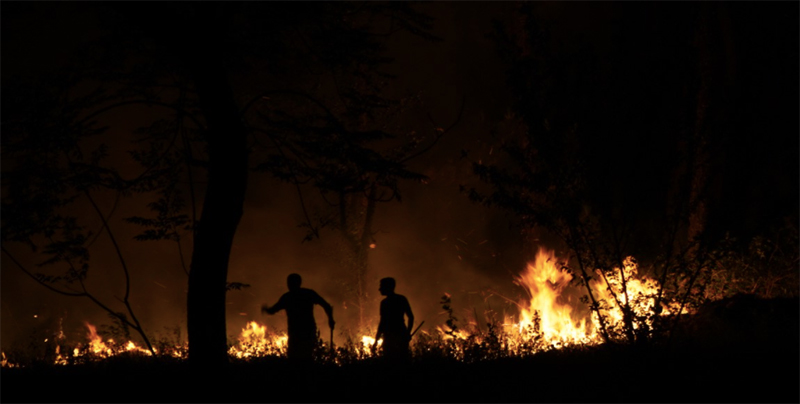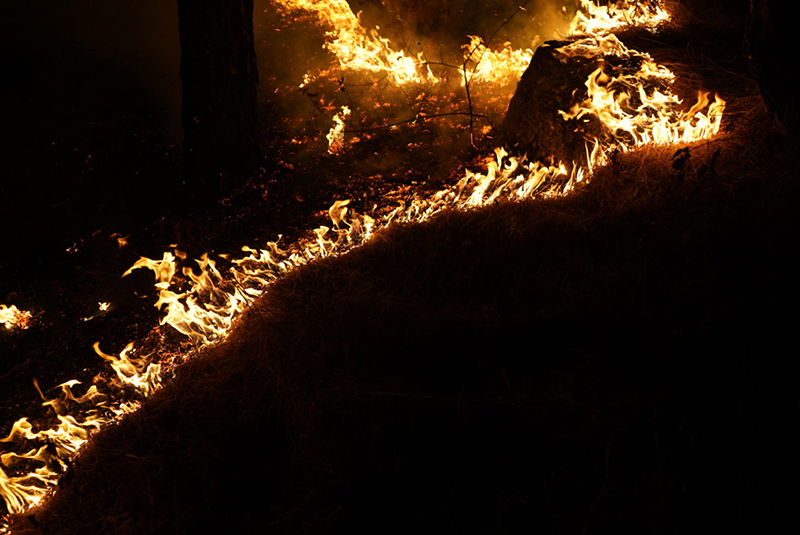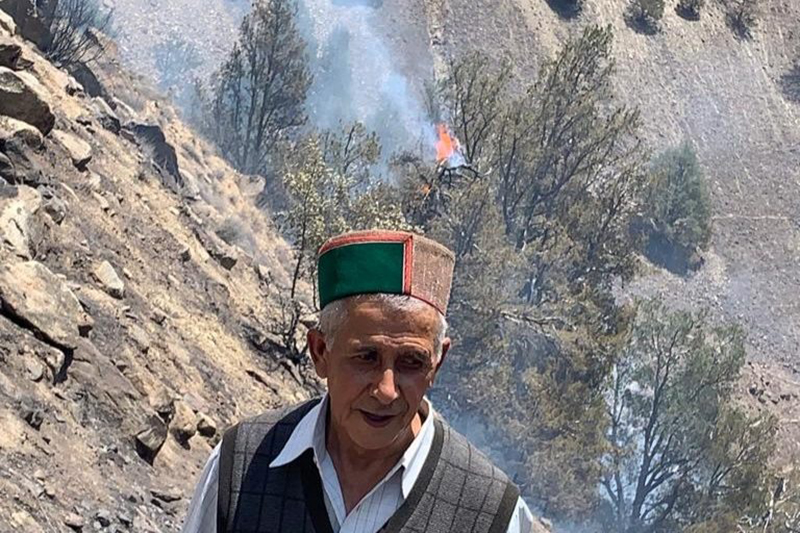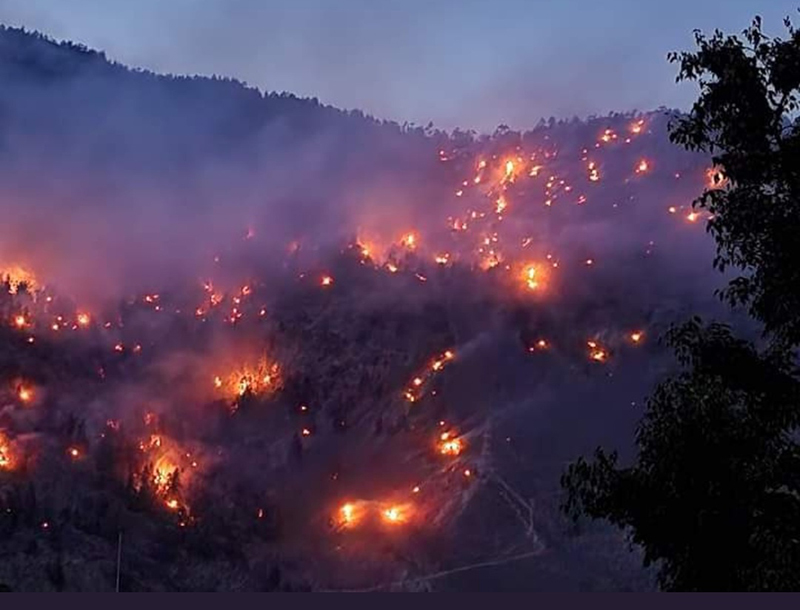 Himachal
Himachal Record number of forest fires imperil Himachal’s ecology
Himachal Pradesh recorded 2,763 incidents of forest fires this year from April 1 to June 30, which is the highest figure recorded by the state’s Forest Protection and Fire Control division, since 2007. While three forest officers lost their lives, over 23,000 hectares of forest area were affected. Senior forest officers state that dry weather spells and human negligence or wilful destruction could be the reasons for the fires. The local people see it as an outcome of large scale development projects. Mongabay India correspondent Vivek Gupta reports
Roshan Lal, 66, is livid. He is yet to come to terms with the damage caused to a forest near his village that caught fire on June 12.
Lal, an agriculturist from Jangi village in Kinnaur district of Himachal Pradesh, told Mongabay-India that he had not seen a forest fire of this scale before. The fire spread over three kilometres and engulfed hundreds of trees and green cover. It took around three days to extinguish the fire but by then, over 2,000 bighas (161 hectares) of forest land had been affected by the fire.
Reginald Royston, District Forest Officer (DFO), Kinnaur, informed Mongabay-India that the report about the exact damage due to the forest fire was still being compiled. However, on the ground, the destruction is quite visible. The fire has affected the ecologically and economically significant deodar and blue pine trees valued for their timber, he said.
“Hundreds of chilgoza pine trees, which produce edible nuts and are a major source of livelihood for residents of Jangi village, were destroyed,” said Lal. The affected area was also home to Himalayan tahr and the black bear, according to Jangi residents. They suspect human tampering as the reason for the fire.
However, DFO Reginald Royston said since the fire occurred on high mountain slopes where there is no human habitation, the department was not able to reach any conclusion whether the fire incident was accidental or a deliberate attempt. “But one possible reason is the prolonged dry spell in the area, which massively reduced the moisture level of the forest, thereby making them more prone to acute fire,” Royston clarified.
 Himachal Pradesh recorded 2,763 fire incidents from April 1 to June 30 2022, with an average of 31 fires per day. Photo by Sumit Mahar/Himadhra Collective.
Himachal Pradesh recorded 2,763 fire incidents from April 1 to June 30 2022, with an average of 31 fires per day. Photo by Sumit Mahar/Himadhra Collective.
Record breaking fire incidents
The forest area in Himachal Pradesh, covers 66 percent of the state’s geographical area and is rich in biodiversity, playing a vital role in preserving the fragile Himalayan ecosystem.
The rising fire incidents in Himachal Pradesh have become a major cause of worry for authorities and citizens, especially when forests are not only crucial for the state’s environmental, ecological and economic well-being, but also provide environmental services to the lowland states.
Several districts of Himachal Pradesh have seen forest fires this year, reveals government data. As per the data shared by Himachal Pradesh’s Forest Protection and Fire Control Division with Mongabay-India, the state recorded 2,763 fire incidents from April 1 to June 30 this year, the usual forest fire season, with an average of 31 fires per day. Dharamshala district topped the chart with 618 fire incidents in this period, followed by Chamba (522), Mandi (364), Shimla (286), Hamirpur (285), Rampur (190), Bilaspur (151) and Solan (110). This, according to the division’s records, is the highest figure recorded by the division since its opening in Bilaspur in 2007.
Comparatively, in previous years, fire incidents in an entire year have been lower than the 2,763 incidents recorded in the state so far. The fiscal year 2021-22 saw 1,275 fire incidents. while 2020-21 had 1,045 fires and 2019-20 had 1,445 fires. Until this year, the highest number of forest fires in a year were in 2009-10 (1,906) and 2018-19 (2,544).
About 23,239 hectares of forest area, which is about 0.45% of the state’s area, were affected in these fire incidents. The total valuation of the impact of the fires was Rs. 64 crores (Rs. 640 million), data revealed. Of the total affected area, 18,600 hectares were part of natural forest areas, and another 4,500 hectares were new plantations, for which the forest department spends a significant amount of money each year on increasing forest cover.
In the efforts to extinguish the forest fires, three forest department personnel – one each in Una, Renukaji and Shimla – died during field operations.
 Roshan Lal from Jangi is worried about the damage to ecologically and economically important pine trees that were destroyed in the recent forest fire near his village. Photo by special arrangement.
Roshan Lal from Jangi is worried about the damage to ecologically and economically important pine trees that were destroyed in the recent forest fire near his village. Photo by special arrangement.
The case of ground fires
Speaking to Mongabay-India, Anil Sharma, Chief Conservator of Forest (CCF), Forest Protection and Fire Control Division, said that most of the forest fire incidents in Himachal were that of ground fires.
“Internationally, forest fires are classified into two-three major categories in which the crown fire (which spreads through the crown (top) of the trees and consumes all the part of the tree), is the most intense and difficult to control. Another category is the ground fire in which loss to the forest is there, but it mostly burns its ground cover and affects the soil,” Sharma explained.
“In this year’s forest fires, the incidents of crown fires were very limited. It was mostly ground fires. There is a chance of revival of green cover of the fire-damaged forest following a good rainy season,” he added.
He also revealed that the state’s chir pine forest, which is spread over 1,259 kms and constitute 3.4 percent of the total forest area of the state is more prone to fire incidents due to its physiology. The department has identified 2,026 beats as per the sensitivity level of the forest fires out of which 339 beats are highly sensitive.
 Fire in a forest area near the Jangi village of Himachal’s Kinnaur district on June 12. Photo by special arrangement.
Fire in a forest area near the Jangi village of Himachal’s Kinnaur district on June 12. Photo by special arrangement.
Rainfall deficiency, dry weather and other factors
CCF Anil Sharma told Mongabay-India that the forest fires in most cases are the result of human negligence. “For instance, if someone threw a burning cigarette or if farmers ignore some burnt leftovers in their fields adjoining the forest areas, it could result in the forest area catching fire. Some fires were intentional too, for the purpose of getting good quality of grass fodder after monsoon.”
“But the prolonged dry spell and higher than normal temperature this season in Himachal actually exacerbated the situation,” said Sharma adding, “The dry leaves in the forest became highly inflammable and spread the fire in forests.”
As per the data obtained from Himachal Pradesh Meteorological Department, the state witnessed 95 percent and 90 percent deficient rainfall in the months of March and April respectively, which according to the director Surender Paul was the highest since 2002. In the months of May and June too, the rainfall deficiency was 23% and 48% respectively, with the upper reaches of Himalayas witnessing unprecedented rainfall deficiency.
Combined with this, the state recorded 27 heatwave days, the third highest in the country after Rajasthan (39) and Madhya Pradesh (38), revealed the report by Centre for Science and Environment (CSE), a Delhi-based non-profit, based on the data from India Meteorological Department (IMD).
While the Met Department predicts normal rainfall from July onwards, Jiya Lal, an environmental activist based in Kinnaur told Mongabay-India, “We all must introspect why there is a huge variation in rainfall and snowfall patterns in the state in past one decade or so.” Lal said that it is the direct consequences of the large-scale development projects that have disturbed overall state’s ecology.
“Besides, global as well as other domestic climate change phenomena is helping in recurrence of dry spells more often than before in Himachal. The net result is immense damage to forest resources, wildlife and the environment,” Lal added.
On how forest fire incidents can be controlled, CCF Anil Sharma said that it is impossible to stop all fire incidents. The key is ‘staying aware’.
“We conduct mass contact programmes with the local people, panchayats, school children, to make them aware about the damages caused by forest fires to the forest resources, wildlife and the environment,” he said.
Sharma said that they have also tied up with Forest Survey of India in Dehradun, and through the help of satellites the authorities from there send an alert whenever they notice smoke billowing in any part of the state’s forest area. “This helps us to reach the spot at the earliest and take all possible means to stop it from spreading further,” he concluded.
(Courtesy: Mongabay India)
Support Our Journalism
We cannot do without you.. your contribution supports unbiased journalism
IBNS is not driven by any ism- not wokeism, not racism, not skewed secularism, not hyper right-wing or left liberal ideals, nor by any hardline religious beliefs or hyper nationalism. We want to serve you good old objective news, as they are. We do not judge or preach. We let people decide for themselves. We only try to present factual and well-sourced news.







